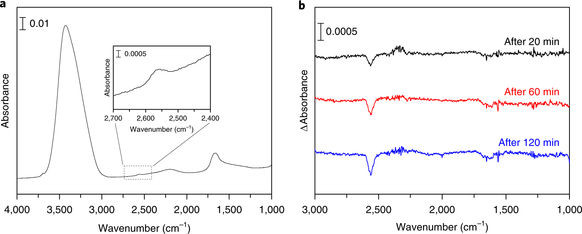擬似星間塵氷からの反応性脱離の赤外分光分析
An infrared measurement of chemical desorption from interstellar ice analogues
2018年2月5日 Nature Astronomy 2 : 228 doi: 10.1038/s41550-018-0380-9

10ケルビンという低温の分子雲中では、水素とヘリウムを除いたすべての化学種は星間塵表面の多成分氷に吸着されて動けないはずである。それにもかかわらず、天文観測によって、これまでに150種類以上の化学種が分子雲の気相で検出されている。つまり、分子がその熱脱離温度以下で塵の表面からガスとして放出されるメカニズムが、極低温の分子雲における化学進化において不可欠である。発熱反応の余剰エネルギーによって引き起こされる反応性脱離は、およそ50年前に重要な脱離機構として初めて提案された。反応性脱離は、原理的にあらゆる温度で、たとえ当該分子の熱脱離温度を下回っていても発生しうる。そのため、宇宙における化学反応ネットワークモデルは一般的にこのプロセスを取り入れてきた。これまでのいくつかの実験的な成果が存在するものの、表面反応による反応性脱離を定量化するために非常に有効な、赤外分光分析は行われていなかった。本論文では、星間空間における硫黄の化学反応として重要なH + H2S → HS + H2(反応1)とHS + H → H2S(反応2)という反応のさなかに起こる反応性脱離をin situで初めて計測したことを報告する。本研究では、反応性脱離はこれまで考えられていたよりも効率的にH2Sを気相へと放出するプロセスであることが明瞭に示された。得られた反応性脱離の有効断面積からは、典型的な星間環境において化学脱離の速度が光脱離の速度より大きいことが示された。
Corresponding Author
In molecular clouds at temperatures as low as 10 K, all species except hydrogen and helium should be locked in the heterogeneous ice on dust grain surfaces. Nevertheless, astronomical observations have detected over 150 different species in the gas phase in these clouds. The mechanism by which molecules are released from the dust surface below thermal desorption temperatures to be detectable in the gas phase is crucial for understanding the chemical evolution in such cold clouds. Chemical desorption, caused by the excess energy of an exothermic reaction, was first proposed as a key molecular release mechanism almost 50 years ago1. Chemical desorption can, in principle, take place at any temperature, even below the thermal desorption temperature. Therefore, astrochemical network models commonly include this process2,3. Although there have been a few previous experimental efforts4,5,6, no infrared measurement of the surface (which has a strong advantage to quantify chemical desorption) has been performed. Here, we report the first infrared in situ measurement of chemical desorption during the reactions H + H2S → HS + H2 (reaction 1) and HS + H → H2S (reaction 2), which are key to interstellar sulphur chemistry2,3. The present study clearly demonstrates that chemical desorption is a more efficient process for releasing H2S into the gas phase than was previously believed. The obtained effective cross-section for chemical desorption indicates that the chemical desorption rate exceeds the photodesorption rate in typical interstellar environments.

